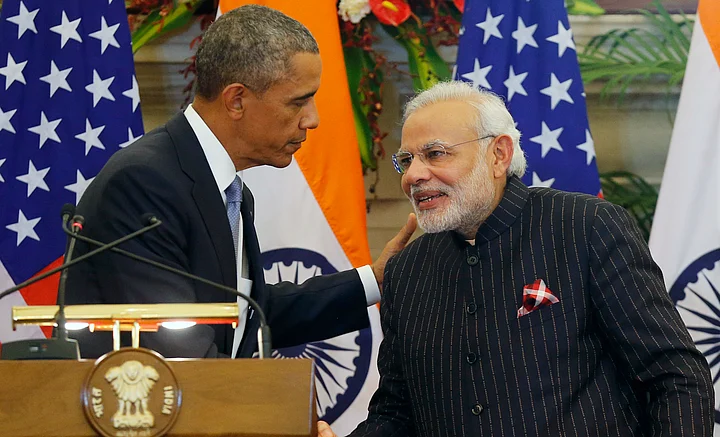At the controversial core of the India-US nuclear deal is the intent. The context was the emerging geopolitics of China’s “peaceful rise” and the need to stop it from dominating Asia.
- Atal Bihari Vajpayee’s BJP government sought technology and American capital.
- There was no need for India to negotiate in the nuclear realm at all.
- The US counter-bait was to supposedly build India as a balancer to China.
- The secret aim was to divert India from the plutonium path and into energy dependency.
- Despite meeting all conditions India has not been conferred membership of NSG.
The Atal Bihari Vajpayee BJP government wanted to seek technology and American capital. The bait was the “voluntary (testing) moratorium”, announced after the May 1998 Shakti tests, notwithstanding a fizzled thermonuclear device that cried out for more testing.
The US government rose to it in the belief that more could be extracted from New Delhi in furtherance of Washington’s long-held non-proliferation objective – the great constant of American foreign policy since the 1974 test – of “capping, freezing, and rolling back” the Indian nuclear weapons capability.
So with the rapprochement rooted in geopolitics and realpolitik, and not in any sentimental nonsense about shared democratic values, there was no need for India to negotiate in the nuclear realm at all, leave alone make concessions and compromises.
But the Jaswant Singh-Strobe Talbott “strategic dialogue” set the ball rolling. However, it took the agency of the “Accidental Prime Minister” – Manmohan Singh, to put wheels under Washington’s multi-pronged policy to contain India’s nuclear weapons programme but also – and this was the counter-bait New Delhi jumped at – to supposedly build India as a balancer to China.
Making India Energy Dependent
The sale of reactors – run on imported highly-enriched uranium – to India to revive a comatose US nuclear industry was a bonus, but its secret aim was to divert India from the plutonium path and into energy dependency. This was a deep game that entirely escaped the strategically challenged Manmohan Singh regime, uplifted by the prospects of US’s help to make India a “major power” and by “20,000 MW by 2020” to spur economic growth.
But back up a bit.
Why was diverting India from the plutonium route critical? Based on India’s easily accessible reserves of thorium – the world’s largest – the nuclear visionary Homi J Bhabha articulated a three-stage interlocking plan in 1955 for energy self-sufficiency. The first stage had natural uranium fuelled reactors to provide the feedstock for the second-stage breeder reactors to, in turn, have its output fire up thorium reactors in the final stage.
The beauty of the Bhabha Plan is that the first and second stages yield weapons-grade plutonium (WgPu). It was an unnerving prospect for the US to imagine an India with limitless energy and weapons material! Bhabha acquired the NRX (so-called CANDU) reactor from Canada.
New Delhi thereafter only needed to have its eye on the ball, keep investing in the development of the breeder and thorium reactors, in order to now have neared the desired end-state.
No Money for Nuke Energy – Yet Enough for Rafale?
Alas, no Indian PM had the requisite vision and the will, and the nuclear energy programme floundered. The momentum from Bhabha’s time carried the country to where the 500 MW breeder reactor is ready for commissioning in Kalpakkam.
But New Delhi has not found the money to upscale the 40MW experimental thorium reactor “Kamini” or to otherwise implement the Bhabha-Plan on a war-footing, but has tens of billions of dollars to spare for wasteful spends, such as on a 4-plus generation Rafale combat aircraft.
And no Indian PM has had the “long view” and guts to try and bring down the oppressive non-proliferation treaty system targeting India by selling the 220 MW CANDU-derivative, the INDU workhorse reactor, to any country with the cash, and to secure the necessary natural uranium from strip-mining reserves in Manipur mountains (and arresting foreign-funded eco-NGO protestors) and from Niger and Gabon.
Besides, creating its own nuclear market in the Third World – India didn’t have to be a member of the Nuclear Suppliers Group (NSG) to sell indigenously produced nuclear goods – New Delhi would have had the West, espying a non-proliferation system breakdown, pleading for mercy. That’s how a country gains respect and leverage. Ask China!
Despite Promises, No NSG Club Membership for India
Except in Manmohan Singh, India found a sap and Washington a sucker. For a pat on the back for leading a “responsible” state – whatever that is – he shifted most of the CANDU reactors into the international safeguards net, thereby stuffing the country’s capacity for surge WgPu production, and decommissioned the 40 MW Cirus reactor before the second military-dedicated 100MW plutonium producer came on stream.
All those who were excited about the nuclear deal — the government, the Indian policy establishment and the media — never wondered why, despite having met all conditions, India has not been conferred “the rights and privileges” of a nuclear weapons state and membership of the NSG as was promised in the July 2005 joint statement between Manmohan Singh and George W Bush.
Would an India armed with proven thermonuclear weapons be more credibly balanced than China?
(The writer is a Research Professor at the Centre for Policy Research and a national security expert)
(At The Quint, we question everything. Play an active role in shaping our journalism by becoming a member today.)
